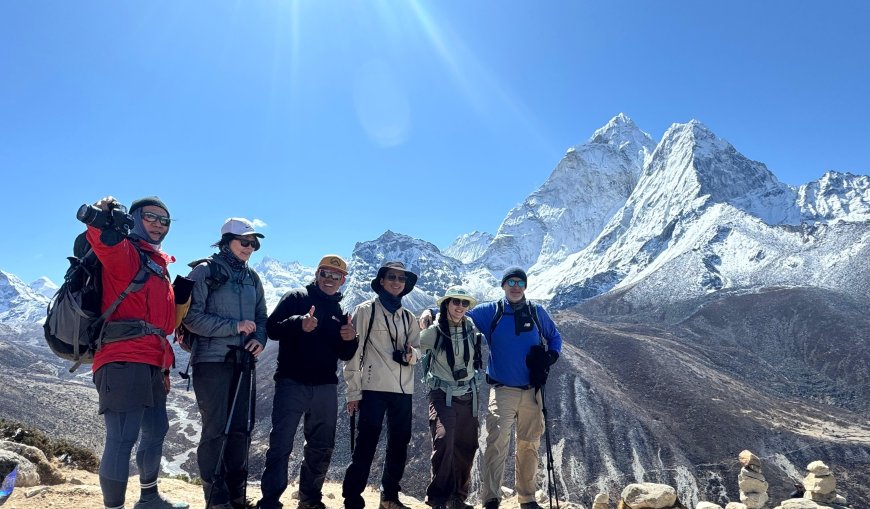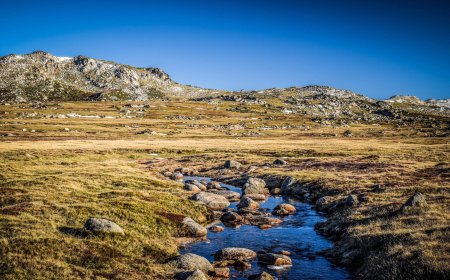How to Reconnect with Nature on Your Everest Base Camp Trekking Adventure
Experience Nepal’s rich mountain culture on the Everest Base Camp trail.

Trekking to Everest Base Camp (EBC) isn't just about getting to a certain spot—it's about beautifully reconnecting with nature. The hike through the Khumbu Valley lets you soak in the outdoors, with stunning mountains, green forests, and calm rivers all around you. As you leave the chaos of everyday life behind, you can find a sense of peace and feel more in tune with your surroundings.
Once you hit the trail, you'll hear the wind in the pine trees and might even spot some wildlife like yaks and snow leopards. The fresh mountain air and impressive views of Everest and the other peaks remind you of nature’s raw beauty and power, making you pause and think.
You’ll walk through ancient Sherpa villages that show how life here is connected to the land. Along the way, you’ll see Buddhist monasteries and colorful prayer flags, reflecting the area’s spiritual ties to the environment.
When you finally arrive at Everest Base Camp Trek Itinerary, the breathtaking scenery makes it clear how we humans fit into the bigger picture of nature. Whether you’re sitting by the icy rivers, catching the sunrise over the mountains, or wandering through quiet woods, EBC is a great spot to reconnect with the natural world.
Reconnecting with Nature on the Everest Base Camp Trek
The Everest Base Camp Trek is a great way to get back in touch with nature. The Khumbu region is filled with stunning sights, like the towering peaks of Everest and Lhotse, along with peaceful rhododendron forests and meadows. As you trek, you’ll pass through small villages like Namche Bazaar and Dingboche, where life is closely tied to the land. You might see wildlife like yaks and Himalayan tahr, and you’ll enjoy the calming sounds of rivers, wind, and birds singing. Every step of the trek invites you to take a moment to breathe and appreciate the beauty around you.
Understanding the Spiritual Connection Between Sherpas and Nature
The Sherpa people have a strong bond with the mountains and their surroundings. During your trek to Everest Base Camp, you'll spot Buddhist monasteries, prayer flags, and stupas that show how much they respect nature. For them, the mountains are sacred, acting as protectors of the area and its people. As you wander through Khumbu villages, you’ll see how locals honor the environment. Knowing about this spiritual connection can make your experience richer, allowing you to see the landscape as more than just a pretty view.
The Healing Power of the Himalayas: Finding Peace on the Trek
One of the best parts of the Everest Base Camp Trek is the peace that comes from being surrounded by nature. The impressive mountains, clear rivers, and fresh alpine air help calm your mind. With each step you take, you’ll likely feel the stress of everyday life fade away. The sight of Mount Everest and the rough terrain reminds you of nature's ability to soothe and restore. Whether you’re taking a quiet moment at Gorak Shep, watching the sunrise, or taking a leisurely walk around the Khumbu Glacier, there are plenty of chances for peace and reflection.
Immersing Yourself in the Wildlife of the Everest Region
The Everest Base Camp Trek isn’t just about amazing views—it's also a chance to see the unique wildlife in the area. While trekking through Sagarmatha National Park, you might spot Himalayan tahr, snow leopards, and yaks. The park is also home to various birds, like the colorful Himalayan Monal and vultures soaring above. As you hike through the rugged Khumbu Valley, you'll get to see how wildlife has adapted to the tough conditions of the Himalayas, making your journey even more special.
The Role of Clean and Fresh Water in the Everest Ecosystem
Clean water is super important in the Everest region. The trek to Base Camp takes you by glacial rivers, alpine lakes, and waterfalls that are essential for both the people and the wildlife around. Knowing how glacial meltwater helps support local ecosystems can make your connection to the region even stronger. Many water sources along the trek are pure, but it’s smart to carry a water purification system to stay safe. The clear water in the Khumbu area serves as a reminder of the delicate balance in nature that we need to keep for future generations.
The Spiritual Meaning of the Everest Base Camp Area
The Everest Base Camp area is more than just beautiful scenery; it holds deep meaning for the Sherpa people and many Buddhists. The mountains are seen as sacred, and as you trek, you’ll notice prayer flags and mani stones with Buddhist prayers along the paths. In places like Tengboche, you can visit Buddhist monasteries where monks carry out rituals aimed at protecting both the mountains and the local environment. These spiritual spots help trekkers feel connected to the land. For the Sherpas, the Himalayas are not just mountains; they’re revered figures.
Practicing Mindfulness on Your Trek to Everest
Trekking to Everest Base Camp is a great way to practice mindfulness. The quiet and peaceful environment gives you a perfect chance to slow down and pay attention to what’s around you. Listening to the wind, smelling the pine trees, and enjoying the views can help you feel calm. Taking your time at places like Namche Bazaar and Gorak Shep makes it easier to focus your thoughts and relax. Each step along the trail can become a moment of mindfulness.
The Environmental Effects of Trekking to Everest Base Camp
While the Everest Base Camp Trek is an amazing experience, it does come with its environmental issues. More trekkers mean more strain on the Sagarmatha National Park’s ecosystem. Challenges like waste management and water preservation are important to consider. To be responsible trekkers, it's vital to use reusable water bottles, steer clear of plastic waste, and follow local eco-friendly practices. By being mindful of how we travel, we can help keep the area’s natural beauty intact while enjoying it.
How the Himalayas Connect Us to Nature
The high peaks of the Himalayas have a way of inspiring awe in everyone who visits, whether they’re trekkers, climbers, or locals. The vast landscapes and the significance of mountains like Everest and Lhotse can be humbling. The trek to Base Camp is a chance to appreciate both the beauty of nature and the brevity of life. Being in the untouched wilderness creates a strong bond with the environment, filling you with gratitude for the natural world. It’s an experience that can reshape how you see nature and your role in it.
Enjoying the Peace of the Everest Region
One of the best parts of the Everest Base Camp trek is the chance to enjoy the calmness of the Himalayas. As you walk through less-traveled valleys, you may find total silence, with only the wind, rivers, and birds to break it. This break from city noise brings an incredible sense of peace. To really soak in these quiet moments, try putting away your electronics and tuning into your surroundings. Whether you're at Gorak Shep watching the sunset over Everest or enjoying the soft sounds of nature in Namche Bazaar, these peaceful experiences will help you reconnect with the world around you.
How to Prepare for Trekking to Everest Base Camp
Getting ready for the Everest Base Camp (EBC) trek means being physically and mentally fit. Start by building your fitness with activities like walking, hiking, running, or biking. It’s smart to strengthen your legs and core since the trails can be steep. Give yourself time to get used to the high altitudes by planning rest days. Don’t forget to get the right gear, like warm clothes, a quality sleeping bag, and good trekking boots. Prepare for the physical parts of the trek by training for endurance. Also, mental readiness is key since it’s a long trek. Make sure you have your travel insurance, permits, and vaccinations sorted out.
What is the Experience of the Everest Base Camp Trek?
The trek to Everest Base Camp is an incredible adventure packed with amazing views, cultural experiences, and physical challenges. You start in Lukla and make your way through Sherpa villages like Namche Bazaar, soaking in the lively local culture. The trail takes you by Buddhist monasteries, colorful prayer flags, and old stupas, with stunning sights of peaks like Mount Everest, Lhotse, and Ama Dablam. While the high altitudes can be tough, each step offers new experiences, whether it's bonding with fellow trekkers or the serenity of the Himalayas. Reaching Base Camp is a big moment, but it’s also about personal growth and being in touch with nature.
How Do You Get Back from Everest Base Camp?
To get back from Everest Base Camp, you’ll follow the same trail back to Lukla, where you’ll catch a flight to Kathmandu. After the hard climb up to Base Camp, the descent is usually easier and can take about 3-4 days, depending on your pace. You’ll pass through familiar spots like Pheriche and Namche Bazaar, giving you a chance to reflect on your trek. Most people choose to fly back to Kathmandu from Lukla, but keep in mind that flights can be delayed because of the weather. It’s a good idea to include some extra days in your plans for any delays.
What to Do After the Everest Base Camp Trek?
Once you finish the Everest Base Camp trek, you might want to either explore more of Nepal or just relax and think about your journey. You could check out Kathmandu and its historic temples, bustling markets, and vibrant Buddhist culture. If you want to keep trekking, consider the Gokyo Lakes trek for fewer crowds or the challenging Three Passes Trek for a longer adventure in the Everest area. For more cultural experiences, the Annapurna Circuit or Langtang Valley are great options. If you prefer to unwind, many trekkers like to enjoy a spa day or do yoga in Pokhara.
Conclusion
Everest Base Camp Trek Package is a fulfilling journey that takes some careful planning, both physically and mentally. You’ll be treated to breathtaking views of the Himalayas, cultural experiences in Sherpa villages, and the excitement of reaching Base Camp. While getting there and back can be tough, the feeling of achievement is truly special. After your trek, you can either explore other parts of Nepal or simply take some time to reflect on the amazing experience you just had. No matter if you decide to go for another trek or relax, your Everest Base Camp adventure will be a memorable part of your travel story.










































